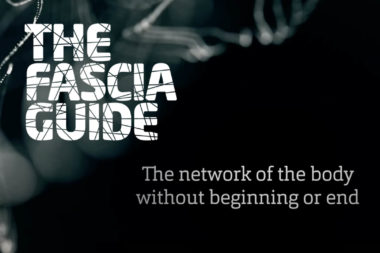

Why is it more common for women to have back pain?
More women than men suffer from back pain, sprains, ACL injuries, and similar conditions. How come?
New research shows how the body’s fundamental structure, the fascia, is affected by factors such as the hormone estrogen which in turn affects the enzyme lysyl oxidase, resulting in the body undergoing self-remodeling from within.
What does Fascia have to do with back pain?
The fascia creates a three-dimensional network in the body, consisting of alternating loose and dense connective tissues, allowing all cells and organ systems in the body to hold together and collaborate as an integrated whole.
Simply put, the fascia can be described as having a solid part and a fluid part, along with cells that produce the components. The solid part is composed of fiber proteins, mostly collagen, and the fluid part is a water-binding gel that largely consists of hyaluronic acid, among other macromolecules.
This solid and fluid part is collectively called the extracellular matrix (ECM), which exists outside the cells. Embedded within the extracellular matrix are cells, such as fibroblasts, fasciacytes, mastcells, and more, which form the components of the ECM and regulate the machinery by constantly communicating with other cells and the surrounding tissue, producing proteins and other molecules as needed.
The solid part, collagen, contributes to the structure and strength, determining the mechanical properties of the fascia at the macro level. The fluid gel governs the fascia’s properties at the micro level, including cell communication and molecular transport.
It is precisely this solid part, collagen, which is needed for strength, but it seems to have difficulty holding together as strongly in women of reproductive age as in men. Why is that?
How does the structure of Fascia differ between men and women?
The hormone estrogen has a significant impact on the composition of collagen, which naturally affects the fascia, tendons, ligaments, and more. Collagen is the most abundant protein in the body and exists in several different types, such as type I, which is the most common collagen in our bodies, and type III, which is a softer collagen commonly found in loose fascia. Type I collagen is a strong and stable collagen that forms robust fibers, even stronger than steel. It is abundant in dense, strong fascia, such as tendons, ligaments, muscle fascia, and the robust aponeurotic fasciae over the abdomen and back, the rectus fascia and thoracolumbar fascia. They help strengthen and stabilize our posture. In loose fascia, for example beneath the skin and interspersed between “layers” of dense fascia, there is a higher proportion of type III collagen.
For collagen fibers to become strong, they require cross-links between collagen molecules to hold and stabilize the fibers. Like most processes involving the body’s synthesis, enzymes are needed to drive the synthesis. The enzyme responsible for creating cross-links in type I collagen is called lysyl oxidase, and it is essential for creating stable and strong collagen. Many cross-links result in a more stable but also stiffer collagen, while fewer cross-links lead to a softer and less stable collagen.
More estrogen = less collagen I and cross-links
According to recent research, the enzyme lysyl oxidase, responsible for creating cross-links in collagen, is affected by estrogen in a way that inhibits its effectiveness. Consequently, fewer cross-links are formed when estrogen levels are high, resulting in weaker collagen in women of reproductive age, particularly around ovulation and during pregnancy.
Estrogen also decreases the synthesis of collagen type I and instead promotes the formation of collagen type III and fibrillin (a glycoprotein in fascia, essential for the formation of the fiber protein elastin). This leads to a softer and less stable fascia. As a result, women are more prone to experiencing back pain, sprains, or ligament injuries. However, they are less likely to experience muscle strains since the collagen in tendons and muscle fascia is more elastic.
Especially during pregnancy when the tissue is more pliable and the musculature and fascia can easily become overstrained due to changes in the center of gravity and body balance. Overstrained fascia can develop micro-damages, triggering an inflammatory response in which hyaluronic acid is significantly involved (see article “Hyaluronic acid and densification”). This inflammation and densification of the fascia also exert pressure on nerve receptors and cause pain.
The production and breakdown of collagen and the formation of new tissue are stimulated by mechanical loading, such as exercise. However, there are differences between genders in this regard. The stimulatory effect on collagen synthesis after exercise is lower in women of reproductive age.
After menopause, when estrogen levels decline, the proportion of collagen I increases compared to collagen III. This results in stiffer, albeit more stable, fascia, which can also contribute to back pain and other myofascial pain due to the “tight suit” effect pressing on pain receptors in the fascia.
Treatment of the fascia to maintain the flow in the liquid part of the fascial system and reduce the stiffness that starts with a densification of the hyaluronic acid and the ground substance, aiming to restore body balance, can help alleviate these problems.
- Fede et al, 2016. Hormone receptor expression in human fascial tissue.
- Fede et al, 2019. Sensitivity of the fasciae to sex hormone levels: Modulation of collagen-I, collagen-III and fibrillin production.
- Kjær et al, 2009. Mechanical loading, tendon, collagen synthesis, tissue adaptation, fibroblast, growth factors, exercise, physical training
- Lee et al, 2015. Estrogen Inhibits Lysyl Oxidase and Decreases Mechanical Function in Engineered Ligaments.
- Lodish et al, 2000. Molecular Cell Biology, 4th edn.



















































